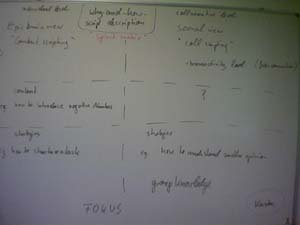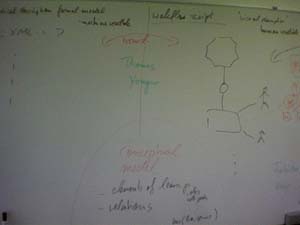MOSIL Mini Camp in Duisburg
Posted: July 20th, 2004 | Comments OffNotes taken during the MObile Support for Integrated Learning (MOSIL) Duisburg minicamp on educational script modelling, IMS-LD, UML and Active Documents. Official outputs are available on the MOSIL BSCW repository.
DAY 1 (July 15)
Presentation of my work from and since Lille
-> see Educational Script Visualization
Andi reports on ICALTS
- interaction and collaboration analysis (for student/teacher interaction regulation)
- analysis in system and outside of systems
- mainly computer-based analysis
- definition of templates to describe and classifiy the environment
- guiding mechanism related into scripting
- analysis is related into monitoring and imposing the scripts
- mention on how hard to find a common ground. Rune mentioned that the goal does not have to be about finding a common ground, but to learn to view a different perspectives
Rune presented Rich picture
- method from the soft methodology area. Not made for machines.
- participatory design
- very important to add meaningful pictures
- picture transport information
- missing timelines and processes for processes
- Mixing SWISH and Rich picture: could be used to show the SWISH diagram with social planes and timelines-
- could be useful for context description
- not usable for science reasons (only to explain the students or have a quick understanding)
- could be useful for awarness
- used as instruction
— Afternoon —
Kay presents a running version of the CopperCore Engine to run IMS LD documents
- engine running on j2ee and only level A of IMS-LD
- not for end user but for system developers
- runs on JBoss and open license
- publish, deliver and delivery of IMS Learning design
- at Duisburg, they develop an editor and modelling tool and another administration editor
- only Valladolid and Netherland have CopperCore running!?
- no concept of sub-roles
Thomas presents his work on IMS-LD to XPDL transformation
- COW is an XPDL engine
- IMS-LD into workflow process
- workflow process to analyze learning
- developped (not finished) to transform from one meta-model to the other (for the moment only IMS-LD to XPDL)
- pedagological view at highest level, and XPDL at lowest level
- transform IMS-LD to run in Cow
- Could be an engine to run IMS-LD. In competition with CopperCore
Reading of papers on the extension IMS-LD
IMS learning design support for the formalization of collaborative learning patterns
-> Collaborative Learning Patterns (CLP) as skeleton
-> tools are introduced to the skeleton
-> extending IMS-LD with explicit description of services
-> lack of description of a service
-> does the engine need to know about group awarness
-> should have a description of service (Valladolid-ext)
-> no design rational
-> important script features embedded in services, not part of the LD document
A Tailorable Collaborative Learning System that Combiens OGSA Grid Services and IMS-LD Scripting
-> Own engine GRIDCOLE searching for service tools according to definition of LD document
CopperCorn hands on
- looking at the versailles example provided
- how to create a manifest and package it
- run “clicc” to create new users and runs
- attach users to roles for the run
- set an active role for the run (need to be active to play the role)
- time and user-complete are the only ending constraitns
- case sensitive
- is a service a blackbox (IMS-LD description does not care about what should happen in the box)?
- no understanding of the data flow (not in Layer A obviously)
- IMS-LD does not handle the workflow (only using references – no exchange the information between the engine and the tool)
- we need to modifiy the collaborative script in order to be design in IMS-LD
DAY 2 (July 16)
** Karsten presents his point of view on What could be scripted in learning
- epistemic activity (content) – what content is learned where
- social modes (eg critics)
- sometimes scripting social modes is more important than epistemic activities
- what kind of cognition and meta-cognition should happen within the script (fear that it would only be wishful thinking)
Brainstorm on several views
Individual level -> Collaborative level
Epistemic view -> social view
“content scripting” “collaboration scripting” (transactivity level) (-> foster connection)
- Design rational = roles, scenarion, strategies
XML (formal model) Workflow script (visual description) spirit matrix
- Try to find the scenario to foster the idea that we have in mind
- Qoc/Ibis tool (decision making tool) to decide what what workflow script
Summary and discussion with Ulrich and Andi on what we did so far
IMS-LD crisism:
- no conceptual model
- UML induces a mental model to the user (supported by the graphical representation)
- for Mosil interesting to have some sort of conceptual model
- the web interface is only the time-based (event-based) representation
- could do some network analysis (measure where things are really happening)
- expectation for Mosil (working on the conceptual model)
- argumentation on what a conceputal model is (does IMS-LD fit?)
- objects (action on object) produce an outcome could describe reflection (for example)
Miao presents his conceptual model based on activity diagram
- what service used for each activity
- document flow
- role defined and assigned to activities
- integrating into an execution tool
- is it important to model the learning process (over-scripting)
- show the concurrent activities
- where is integrated learning? very much constraint based
- dynamic change of membership is not expressed in IMS-LD (neither can the data flow can be represented)
Karsten shows Quoke
- decision making tool (question, option, criterion (importance), edges)
- could be part of a workbench (how things are connected – learning process editor)
- could be attached to a conceptual model element to explain why we do that
- use it to know what service to be used on what context



